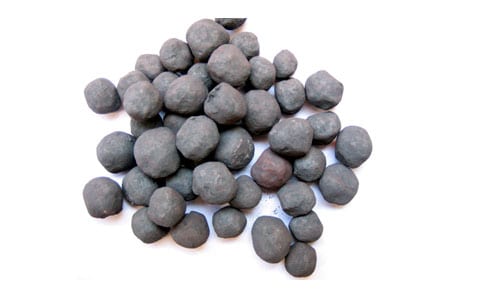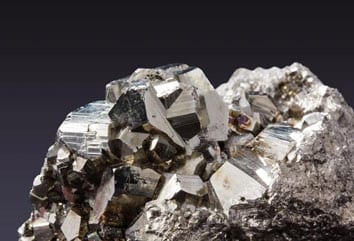Aukeratu Hizkuntza:
Iron ore is the fourth most common element in the earth’s crust. Iron is essential to steel manufacturing and, beraz, an essential material for global economic development. Iron ere oso hedatuta eraikuntzan erabilitako eta ibilgailuen fabrikazioan. Most iron ore resources are composed of metamorphosed banded iron formations (BIF), bertan burdin normalean oxido eran topatu, hydroxides, eta, to a lesser extent, carbonates.
The chemical composition of iron ores is apparent to be wide, especially for Fe content and associated gangue minerals. Major iron minerals associated with most iron ores are hematite, goethita, limonite, and magnetite. burdin mineral kutsatzaile nagusiak hauek dira SiO2 eta Al2O3. The typical silica and alumina-bearing minerals present in iron ores are quartz, kaolinite, gibbsite, burdina edukia handitzeko eta ganga-mineralen kontzentrazioa gutxitzeko prozesatu behar dira, burdin minerala onuratzeko teknologia ezberdinen ezaugarrietan zehar ibiliko zaitu. Horietatik, it is often observed that quartz is the main silica-bearing mineral, and kaolinite and gibbsite are the two main alumina-bearing minerals.


Iron ore extraction is mainly performed through open pit mining operations, esanguratsua tailings belaunaldi ondorioz. burdina ekoizpen-sistema normalean hiru etapa dakar: meatzaritza, prozesatzeko, and pelletizing activities. Processing ensures that an adequate iron grade and chemistry are achieved prior to the pelletizing stage. Prozesatzeko ditu barne birrintzeko, sailkapen, fresaketa, and concentration, with the aim of increasing the iron content while reducing the amount of gangue minerals. Each mineral deposit has its own unique characteristics with respect to iron and gangue-bearing minerals, and therefore, it requires a different concentration technique.
Magnetic separation is typically used in high-grade iron ore beneficiation, where the dominant iron minerals are ferro and paramagnetic. Hezea eta lehorra intentsitate txikiko bereizketa magnetikoa (LIMS) techniques are used to process ores with strong magnetic properties, such as magnetite, while wet high-intensity magnetic separation is used to separate the Fe-bearing minerals with weak magnetic properties, such as hematite, from gangue minerals. Iron ores such as goethite and limonite are commonly found in tailings and do not separate very well by either technique.

Flotazio ezpurutasunak edukia behe-mailako burdin mineral murrizteko erabiltzen da. Burdin mineral kontzentratu daitezke bai anioniko zuzeneko burdin oxidoen flotazio bidez edo alderantzizko kationiko silizea flotazio; ordea, reverse cationic flotation remains the most popular flotation route used in the iron industry. The use of flotation is limited by the cost of reagents, the presence of silica and alumina-rich slimes, and the presence of carbonate minerals. Gainera, flotation requires wastewater treatment and the use of downstream dewatering for dry final applications.
The use of flotation for the concentration of iron also involves desliming, as floating in the presence of fines results in decreased efficiency and high reagent costs. Desliming bereziki alumina kentzea gibbsite bereizketa hematite edo goethita batetik edozein gainazal-aktiboa eragile gisa kritikoa da oso zaila. Most alumina-bearing minerals occur in the finer size range (<20a), kentzearen bidez kentzea ahalbidetuz. Oro har, isun kontzentrazio handia (<20a) eta aluminak behar den kolektore katioiko-dosia handitzen du eta selektibitatea nabarmen murrizten du. Hori dela, desliming increases flotation efficiency but results in a large volume of tailings and in loss of iron to the tailings stream.
Burdin mineralaren prozesamendu lehorrak flotazioarekin eta bereizketa magnetiko hezeko zirkuituekin lotutako kostuak eta isats hezeak sortzeko aukera eskaintzen du.. STET has evaluated several iron ore tailings and run-of-mine ore samples at bench scale (aurre-bideragarritasun eskala). Burdinaren eta silikatoen mugimendu nabarmena ikusi zen, beheko taulan nabarmendutako adibideekin.

Ikerketa honen emaitzek erakusten ari behe-mailako burdina isunak duten STET tribo-elektrostatikoa Gerriko banatzailea bitartez berritu ahal. STET esperientzian oinarrituta, produktu berreskuratzeko edo / eta kalifikazioa egingo du nabarmen pilotua eskala prozesatzeko hobetzeko, aldean nekazaritza-eskala proba gailua horiek burdina entsegu zehar erabilitako gisa.
The STET dry electrostatic fine iron ore separation process offers many advantages over traditional wet processing methods, hala nola, magnetismoa edo flotazioa, barne:
Contact us to learn more about dry processing of iron ore.
erreferentziak:
Iron ore beneficiation involves a series of processes that aim to improve the purity and quality of raw iron ore. These processes include crushing, artezketa, bereizketa magnetikoa, flotazio, and gravity separation, depending on the mineralogical characteristics of the ore. Each technique is selected based on the ore’s composition and feasibility to extract the maximum amount of iron while minimizing impurities.
Iron ore mining requires specialized equipment to handle the extraction and processing of ore. Common machinery includes ball mills for grinding, crushers for reducing the size of ore, magnetic separators for separating iron particles from impurities, flotation machines for fine particle separation, and conveyors for transport.
Technologies utilized for iron ore beneficiation include advanced techniques such as dry electrostatic separation, flotazio, advanced gravity separation, and sensor-based sorting. These technologies aim to efficiently increase the iron content and eliminate contaminants, catering to the growing demand for high-grade iron ore and promoting sustainable mining practices.
The cost of iron ore beneficiation can vary significantly depending on the specific processes and technologies used, the grade of the raw ore, and the desired purity of the final product. It encompasses capital expenditure (CAPEX), such as equipment and plant construction, and operational expenditure (OPEX), including labor, energia, eta kontsumigarriak. It’s essential for companies to evaluate these costs against prospective revenue and market demands to ensure project viability.